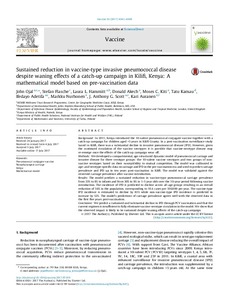Sustained reduction in vaccine-type invasive pneumococcal disease despite waning effects of a catch-up campaign in Kilifi, Kenya: A mathematical model based on pre-vaccination data
Scott JAG; Kamau T; Hammitt LL; Nurhonen M; Auranen K; Akech D; Adetifa I; Flasche S; Ojal J; Kiti MC
Sustained reduction in vaccine-type invasive pneumococcal disease despite waning effects of a catch-up campaign in Kilifi, Kenya: A mathematical model based on pre-vaccination data
Scott JAG
Kamau T
Hammitt LL
Nurhonen M
Auranen K
Akech D
Adetifa I
Flasche S
Ojal J
Kiti MC
ELSEVIER SCI LTD
Julkaisun pysyvä osoite on:
https://urn.fi/URN:NBN:fi-fe2021042717561
https://urn.fi/URN:NBN:fi-fe2021042717561
Tiivistelmä
Background: In 2011, Kenya introduced the 10-valent pneumococcal conjugate vaccine together with a catch-up campaign for children aged <5 years in Kilifi County. In a post-vaccination surveillance study based in Kilifi, there was a substantial decline in invasive pneumococcal disease (IPD). However, given the continued circulation of the vaccine serotypes, it is possible that vaccine-serotype disease may re-emerge once the effects of the catch-up campaign wear off.Methods: We developed, a compartmental, age-structured dynamic model of pneumococcal carriage and invasive disease for three serotype groups: the 10-valent vaccine serotypes and two groups of non vaccine serotypes based on their susceptibility to mutual competition. The model was calibrated to age- and serotype-specific data on carriage and IPD in the pre-vaccination era and used to predict carriage prevalence and IPD up to ten years post-vaccination in Kilifi. The model was validated against the observed carriage prevalence after vaccine introduction.Results: The model predicts a sustained reduction in vaccine-type pneumococcal carriage prevalence from 33% to 8% in infants and from 30% to 8% in 1-5 year olds over the 10-year period following vaccine introduction. The incidence of IPD is predicted to decline across all age groups resulting in an overall reduction of 56% in the population, corresponding to 10.4 cases per 100,000 per year. The vaccine-type IPD incidence is estimated to decline by 83% while non-vaccine-type IPD incidence is predicted to increase by 52%. The model's predictions of carriage prevalence agrees well with the observed data in the first five years post-vaccination.Conclusion: We predict a sustained and substantial decline in IPD through PCV vaccination and that the current regimen is insufficient to fully eliminate vaccine-serotype circulation in the model. We show that the observed impact is likely to be sustained despite waning effects of the catch-up campaign. (C) 2017 The Author(s). Published by Elsevier Ltd.
Kokoelmat
- Rinnakkaistallenteet [19207]
